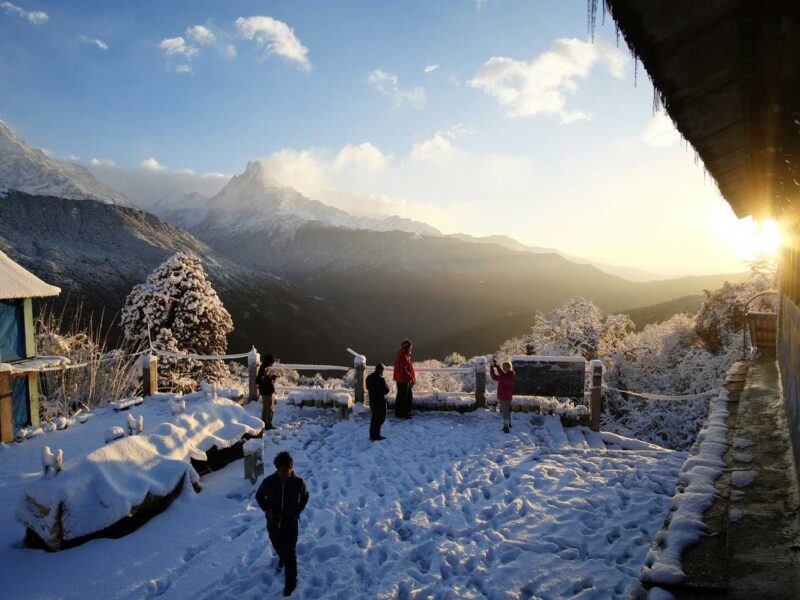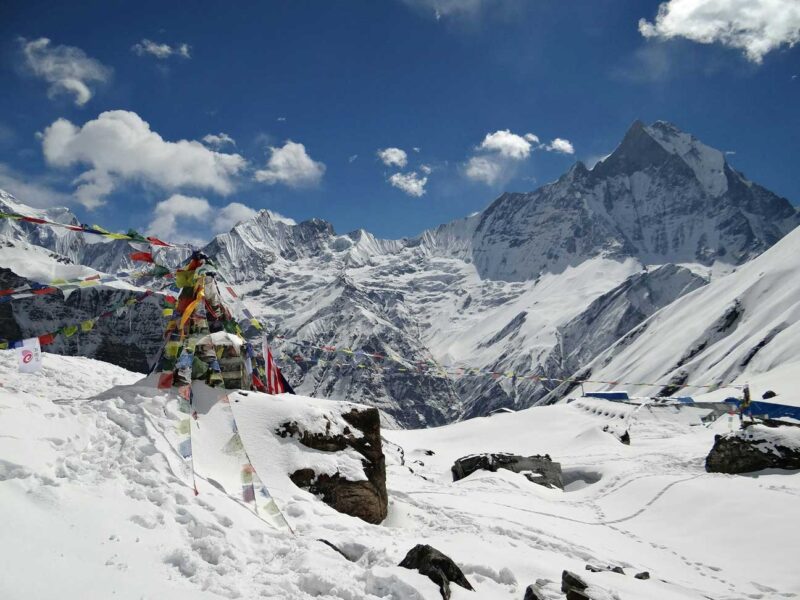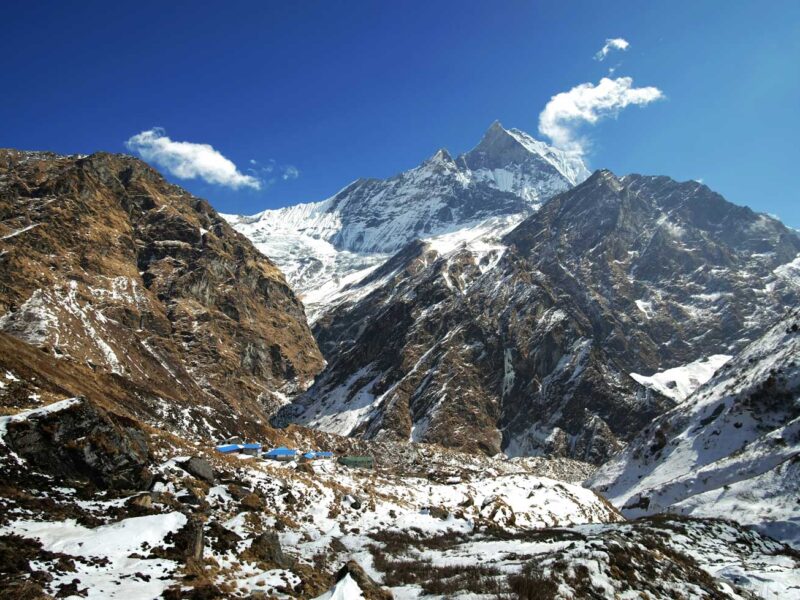Annapurna Base Camp Trek: A Journey to the Heart of the Himalayas



The Annapurna Base Camp Trek (ABC Trek) is one of Nepal’s most enduring adventures—a supremely satisfying combination of mountain landscape, cultural variety, and personal challenge. Accommodating trekkers of all experience levels, the trek brings you deep within the Annapurna Sanctuary, with close-up views of the breathtaking Himalayan giants.
Why Annapurna Base Camp Trek?
Situated in the middle of the Annapurna Sanctuary, the ABC trek offers a stunning mix of gigantic snow-peaked mountains, thick rhododendron forests, terraced fields, and hospitality of the local Gurung and Magar inhabitants. The trek leads you into the lap of Mt. Annapurna I (8,091m)—the 10th highest peak in the world.
Key Highlights
- Panoramic Views of Annapurna I, Machapuchare (Fishtail), Annapurna South, Hiunchuli, and Gangapurna
- Traditional Villages such as Ghandruk and Chhomrong
- Hot Springs at Jhinu Danda
- Cultural Immersion in Gurung and Magar communities
- Annapurna Sanctuary – a natural amphitheater surrounded by giants
Tips for Trekkers
- Moderate fitness is adequate, but practice uphill walking.
- Hydrate and go slowly to avoid altitude sickness.
- Carry cash, as there are no ATMs along the trek.
- Eco-friendly policies are preferred – leave no trace!
Why Is The ABC Trek Special?
Up-Close Himalayan Panoramas – You eyeball-to-eyeball with Annapurna I, Annapurna South, Machapuchare (Fishtail), and Hiunchuli.
360-Degree Mountain Amphitheater – Snow peaks in all directions at ABC.
Variety of Landscapes – Terraced fields, bamboo grove, alpine meadow, and glacier valley.
Rich Cultural Experience – Experience Gurung and Magar hospitality, local tea houses, and prayer flags flapping in the air.
Trekking Itinerary Summary (7–12 Days)
Day Route︿ Highlights
1 Pokhara to Nayapul, trek to Tikhedhunga/Ulleri Scenic drive, green farmland trek
2 Trek to Ghorepani Rhododendron forests, mountain lodges
3 Poon Hill sunrise, trek to Tadapani
Panoramic sunrise over Annapurna & Dhaulagiri
4 Trek to Chhomrong
Machapuchare views, local village charm
5 Chhomrong to Himalayan/Deurali
Bamboo forests, rivers, waterfalls
6 Trek to Annapurna Base Camp (ABC)
Passing Machapuchare Base Camp (MBC)
7 Return to Bamboo or Jhinu Danda
Optional hot springs at Jhinu Danda
8 Trek to Nayapul, drive back to Pokhara
End of the journey
Optional: You can skip Ghorepani-Poon Hill to reduce the trek to 6–7 days.
Best Time to Trek
Spring (March–May): Clear weather, rhododendron bloom
Autumn (September–November): Cool, crystal-clear mountain scenery
Winter (December–February): Fewer tourists, snowy trails (cold & challenging)
Monsoon (June–August): Heavy rain, landslides—not recommended
Accommodation and Cuisine
Tea Houses/Lodges: Cozy wooden rooms, blankets provided, shared restrooms.
Cuisine: Dal Bhat (rice, lentils), momo (dumplings), noodles, pancakes, and yak cheese.
Hot Showers & Wi-Fi: Available at lower altitudes (extra cost).
Permits You Require
ACAP Permit: NPR 3,000 (approximately USD 25)
TIMS Card: NPR 2,000 (approximately USD 15)
Both the permits are available in Kathmandu or Pokhara from the offices of Nepal Tourism Board.
Detailed Packing List
- Trekking boots (broken-in)
- Thermal inner wears and fleece jackets
- Down jacket (for overnight stays at ABC)
- Raincoat/poncho
- Trekking poles
- UV sunglasses and sunblock
- Water purification tablets
- First-aid kit and medicine
- Headlamp and batteries
- Power bank
ABC Trekking Tips for a Memorable Adventure
Train Before You Go – Cardio, hill walk, and squats are helpful!
Acclimatize Properly – Don’t rush the climb.
Hydrate Constantly – Aim 3-4 liters per day.
Eat Enough Calories – Body fuel on long hike days.
Respect Local Culture – Dress modestly, greet with “Namaste”.
Support Local Economy – Employ local guides and porters.
Estimated Budget (Per Person)
Permits – $40
Accommodation (10 days) – $80–$150
Food (3 meals/day) – $100–$150
Guide & Porter (optional) – $200–$300
Transportation (Pokhara/Nayapul) – $20–$50
Misc (Wi-Fi, hot showers, snacks) – $30–$50
Total Estimate: $500–$800 for 10–12 days (excluding flights)
Getting There
- International Flight to Kathmandu
- Domestic Flight or Bus to Pokhara
- Private Jeep or Local Bus to Nayapul (start point)
Cultural Encounters Along the Trek
Gurung and Magar Villages – Experience traditional lifestyles, farming methods, and architecture.
Homestays with locals – Enjoy genuine Nepali hospitality in Ghandruk or Chhomrong.
Buddhist Monasteries & Prayer Wheels – Spin prayer wheels and visit local temples along the trail.
Festivals Along the Way – If you’re lucky, you may experience Dashain, Tihar, or mountain festivals.
Nature and Wildlife
Rhododendron Forests – Especially stunning during the flowering season.
Bird Watching – Spot Himalayan monals, eagles, and sunbirds.
Langurs and Macaques – Playful monkeys often spotted near bamboo forests.
Himalayan Fauna – Rare sightings include snow leopards and musk deer (more common in offbeat trails).
Connectivity and Digital Detox
Wi-Fi Access – Available in most lodges for a small fee, but becomes unreliable at higher altitudes.
Mobile Network – NTC and Ncell offer patchy coverage. Better to inform the family you’ll be offline.
Digital Detox – Welcome the chance to log out and immerse yourself in nature.
Wellness & Spiritual Side
Yoga-Friendly Environments – ABC’s sunrise yoga is surreal.
Nature Meditation – Peace of the sanctuary is ideal for reflection.
Healing Energy – Locals feel that the Annapurna Sanctuary is spiritually charged.
Alternative Routes and Add-ons
Annapurna Circuit – Combine with ABC for a longer, circuit-style trek.
Mardi Himal Trek – Use ABC from Forest Camp or Low Camp for a range of views.
Poon Hill Detour – Offers more Dhaulagiri views and more sunrise magic.
Khopra Ridge Trek – Less crowded, off-the-beaten-path alternative nearby.
Photography Tips
Golden Hour at ABC – Capture alpenglow on Annapurna South and Machapuchare.
Milky Way Shots – Night skies at high altitudes are great with no light pollution.
Drone Use – Allowed with special permits; always ask permission before flying over villages.
Portraits of Locals – First, ask permission; most are happy to smile for the photographer!
Trekking Styles Available
Independent Trekking – For experienced trekkers.
Guided Trekking – Less risk, more information, and benefits locals’ employment.
Porter-Supported Trekking – Relaxes the physical burden and serves as a cultural link.
Group Tours – Best for solo travelers who want company and sharing of costs.
Safety and Emergency Tips
Altitude Sickness Awareness – ABC is 4,130m; ascend gradually and drink lots of fluids.
Travel Insurance – Should cover helicopter rescue in high-altitude trekking.
Emergency Contacts – Carry phone numbers of local organizations and embassies.
Evacuation Plan – Helicopter evacuation from ABC possible if needed (weather permitting).
Sustainable Trekking Tips
Carry a Reusable Water Bottle – Purify with purification tablets or UV filters.
Avoid Plastic – Do not buy disposable bottles or treats with non-biodegradable packaging.
Be Respectful to Wildlife – Never feed or approach wildlife.
Support Environmentally-Friendly Lodges – Choose tea houses powered by solar energy and effective waste management.
Interesting Trivia about ABC Trek
Machapuchare (Fishtail) remains unclimbed and is a sacred mountain.
Annapurna I was the first ever 8,000m to be climbed (1950).
The ABC trail was originally traversed by yak caravans and herders.
“Annapurna” translates to “Goddess of Harvests” in Sanskrit.
✅ Final Checklist Before Leaving
✅ Permits all in hand (ACAP + TIMS)
✅ Adequate cash in Nepali rupees (no ATMs along the trail)
✅ Weather forecast checked
✅ Guide/porter booked (if necessary)
✅ Gear inspected and packed
✅ Travel insurance organized
✅ Flights/buses to Pokhara reserved
Why You’ll Never Forget ABC Trek
- Witnessing sunrise at ABC while Annapurna glows pink and gold
- Soaking in hot springs after days of trekking
- Sharing stories with fellow travelers in mountain tea houses
- Gaining a new perspective on nature, culture, and yourself.